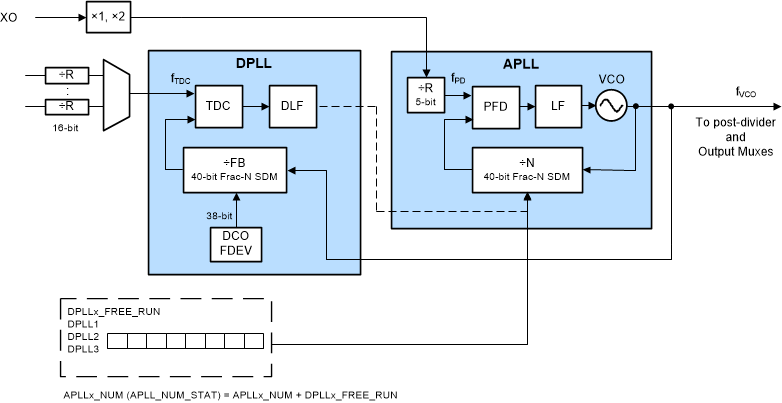ZHCSLT9B March 2022 – July 2022 LMK5B33216
PRODUCTION DATA
- 1 特性
- 2 应用
- 3 说明
- 4 Revision History
- 5 Pin Configuration and Functions
- 6 Specifications
- 7 Parameter Measurement Information
-
8 Detailed Description
- 8.1 Overview
- 8.2 Functional Block Diagram
- 8.3
Feature Description
- 8.3.1 Oscillator Input (XO)
- 8.3.2 Reference Inputs
- 8.3.3 Clock Input Interfacing and Termination
- 8.3.4 Reference Input Mux Selection
- 8.3.5 Hitless Switching
- 8.3.6 Gapped Clock Support on Reference Inputs
- 8.3.7 Input Clock and PLL Monitoring, Status, and Interrupts
- 8.3.8
PLL Relationships
- 8.3.8.1 PLL Frequency Relationships
- 8.3.8.2 Analog PLLs (APLL1, APLL2, APLL3)
- 8.3.8.3 APLL Reference Paths
- 8.3.8.4 APLL Phase Frequency Detector (PFD) and Charge Pump
- 8.3.8.5 APLL Feedback Divider Paths
- 8.3.8.6 APLL Loop Filters (LF1, LF2, LF3)
- 8.3.8.7 APLL Voltage-Controlled Oscillators (VCO1, VCO2, VCO3)
- 8.3.8.8 APLL VCO Clock Distribution Paths
- 8.3.8.9 DPLL Reference (R) Divider Paths
- 8.3.8.10 DPLL Time-to-Digital Converter (TDC)
- 8.3.8.11 DPLL Loop Filter (DLF)
- 8.3.8.12 DPLL Feedback (FB) Divider Path
- 8.3.9 Output Clock Distribution
- 8.3.10 Output Channel Muxes
- 8.3.11 Output Dividers (OD)
- 8.3.12 SYSREF/1PPS
- 8.3.13 Output Delay
- 8.3.14 Clock Outputs (OUTx_P/N)
- 8.3.15 Glitchless Output Clock Start-Up
- 8.3.16 Clock Output Interfacing and Termination
- 8.3.17 Output Synchronization (SYNC)
- 8.3.18 Zero-Delay Mode (ZDM) Synchronization
- 8.3.19 Time Elapsed Counter (TEC)
- 8.4 Device Functional Modes
- 8.5 Programming
-
9 Application and Implementation
- 9.1 Application Information
- 9.2 Typical Application
- 9.3 Do's and Don'ts
- 9.4 Power Supply Recommendations
- 9.5 Layout
- 10Device and Documentation Support
- 11Mechanical, Packaging, and Orderable Information
8.4.5 APLL Frequency Control
The device can also support APLL frequency and phase control through writing the 40-bit register DPLLx_FREE_RUN[39:0] while the DPLL is in holdover or not used. If the reference clock in a free-run mode or disabled, DPLL will disconnect with APLL, but users can still adjust frequency and phase accuracy.
To enable APLL DCO control, set DPLLx_LOOP_EN = 1, and PLLx_MODE = 1 for 40-bit fractional denominator. DPLLx_EN may be set = 0.

Figure 8-39 APLL DCO Mode
There are two alternative methods in adjusting the APLL DCO.
- Absolute frequency
adjustment
- Set DPLLx_HIST_EN = 0
- Effective APLLx_NUM
(APLLx_NUM_STAT) = APLLx_NUM + DPLLx_FREE_RUN
- The APLLx_NUM_STAT is a read-only register and can be read back.
- The DPLL loop filter block will modify the APLLx_NUM_STAT based on DPLLx_FREE_RUN value.
- DPLLx_FREE_RUN is a 40-bit 2s complement number
- Relative frequency
adjustment
- Set DPLLx_HIST_EN = 1
- DPLLx_FREE_RUN value is fed into the APLLx_NUM at a controlled rate defined by a step size register and step period register.
- If another DPLLx_FREE_RUN write occurs before the LMK is complete in making the last adjustment, any remaining steps are lost and the new value begins to feed the APLL numerator.
- A flag is set when the DPLLx_FREE_RUN word is fully fed into the effective APLLx_NUM (APLL_NUM_STAT).